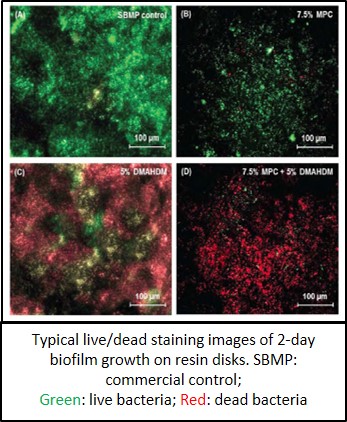Overview
The mechanism underlying dental caries is demineralization through the attack by acid generated by acidogenic bacteria. Acidogenic bacteria growth typically occurs in plaque and biofilm. When biofilms forms at the tooth restoration margins, the demineralization of the enamel and dentin leads to secondary caries, restorative material fractures, and worsening failure of the tooth. Researchers at UMB have developed the first protein-repellent dental composites and bonding agents that can repel biofilm and plaque at the tooth restoration. When combined with the antimicrobial agents and remineralization agents of the invention, secondary caries are significantly reduced.
Protein-repellent adhesive formulations incorporating quaternary ammonium methacrylates, such as 2-methacryloyloxyethyl phosphorylcholine (MPC) can inhibit protein adsorption and bacteria attachment. MPC has been used to repel protein absorption and prevent bacterial adhesion in medical applications but had not been previously used in dental products. UMB researchers have incorporated MPC, new antibacterial quaternary ammonium monomers, and remineralization agents into dental composite and bonding agents. These unique formulations have demonstrated excellent mechanical properties, reduced bacteria attachment, and reduction of secondary caries in animal models.

Applications
According to the National Institute of Dental and Craniofacial Research, 92% of adults ages 20-64 in the US have had dental caries in their permanent teeth, with an average of 3.28 decayed or missing permanent teeth and 13.65 decayed and missing permanent surfaces. The CDC reports 84% of all adults in the same age range have had a dental restoration. The US market for dental materials had a market value of ~$1 billion in 2013 and is expected to grow to $1.5 billion by 2020. An expanding aging population and the increased prevalence of dental caries is expected to lead to a rise in tooth repair procedures and thus a growing demand for dental restoration supplies such as composite resins, amalgams, bonding agents, and dental ceramics. The dental materials market is very dynamic, as there are continuous technological advancements in the field.
Advantages
First dental material to inhibit biofilm growth
Can be applied to multiple other types of dental materials
Stage of Development
This technology has been tested in vitro in multiple species of periodontist-related biofilms.
(As of 2/23/2017)- MEW
Licensing Potential
Available for licensing
Contact Info
Office of Technology Transfer
620 W Lexington St., 4th Floor
Baltimore, MD 21201
Email: [email protected]
Phone: (410) 706-2380